
|
|
Back from the The Dark Side - a Very Obscure Italian!
During early to mid-2024, I was engaged in researching the life and work of the celebrated model engine manufacturer Uberto Travalgi of Rome, Italy. Travalgi was a notable figure in Italian aeromodelling history who is best remembered by model engine enthusiasts for his superbly-made and highly innovative Atomatic and Super Antares diesels of the 1940’s. My objective was the development of a detailed article on Travalgi's work which will appear on this website in due course. The engine which is the subject of the present article came into my hands through eBay in May 2024 while my research on Travalgi was still ongoing. It was sold on eBay as an The engine’s early date was seemingly confirmed by its use of a hardened steel piston operating in a cylindrical (no taper) hardened steel bore – a tricky combination which was abandoned early on by most diesel constructors. Although the identification cannot be claimed as absolutely certain, it’s far more likely than not that this is an example of Travalgi’s early experimental work during 1944, when he is known to have made a few beam mount engines as well as the odd sideport model. The subsequent Atomatic and Super Antares units were all radially-mounted rotary valve designs.
My initial research into this engine’s provenance was undertaken in concert with my valued friend and colleague Peter Valicek of the Netherlands. Having some extremely knowledgeable contacts in Italy, Peter contacted them to see if they could help. However, the results were disappointing – none of the Italians were able to identify the engine. They confirmed that it wasn’t an Antares, a fact which we already knew, but also claimed that it wasn’t any documented example of Travalgi’s work. That said, they were unable to identify any alternative maker - their opinion was that it was a product of some unknown artisan constructor.
Chinn stated that the engine in question was "a one-off design made to order", noting that he had acquired it in Italy during WW2 service there. Chinn later recalled that he had tested the engine during 1946 while aboard a motor launch off the island of Giudecca in Venice. Unfortunately, Chinn stopped short of naming either the manufacturer or the city of origin. Now there's absolutely no question that the engine in Chinn's images is the one under discussion here. If it was indeed a custom-made engine produced to Chinn's special order, as clearly implied in his text, then this must be that very engine!! It’s known that beginning in mid-1944, when Rome was liberated by the Allies, Uberto Travalgi’s “Aviominima” shop at 50A Via San Basilio in Rome was visited by a number of Allied servicemen who were model enthusiasts, including John Zaic, the younger brother of well-known American modelling personality and author Frank Zaic. It now appears that John Zaic may not have been the only Allied serviceman with modelling connections to visit Travalgi's shop in Rome!
The fact that Peter Valicek’s Italian contacts were unable to identify the engine is readily explained - there was only one example, and it went to England with Chinn! No other examples of this particular design appear to be known, providing support for Chinn’s characterization of the engine as a one-off.
Fast-forward to the 1980’s! At some point during that decade, Chinn suffered a great misfortune when his house was broken into and a number of his rarer and more significant engines were stolen. Within the collector community, suspicion centered around an individual who lived near Chinn at the time and was known in the community - only someone who knew about Chinn’s collection and its value on the collector market as well as having an awareness of avenues for advantageous disposal of the engines would have targeted those engines and left the silverware alone! However, no charges were ever brought – the perpetrator covered his tracks too well. Accordingly, the true identity of the perpetrator remains unknown as far as the record goes. For this reason, no names will be mentioned here. Although it’s not absolutely certain – the maker could have produced more than one example of the same custom-ordered unit - the chances are that this engine was among the items stolen from Chinn. So how did it end up in North America in my possession? Well, it must be quite apparent that disposal of Chinn’s engines in England, or even their open display there, would have been far too risky, almost certainly leading to the unmasking of the thief. Presumably for this reason, the prime suspect (or whoever was actually responsible) made periodic visits to the USA, during which he seems to have attended events like MECA collectos to sell engines brought from England. Those events were attended by many well-heeled collectors who would be unfamiliar with events in far-away England.
It bears repeating that there is no hard evidence linking any particular individual to this very shady sequence of events. However well-founded, suspicion alone is not enough to establish certainty. All that I The above sequence of events leaves little doubt in my own mind that this engine is more likely than not to be one of the items stolen from Peter Chinn (right) back in the day. However, even if it is, there’s nothing that I can do about it now – Chinn has been gone for almost 20 years at the time of writing, so I can’t return it, even if it could somehow be proved conclusively that it was his engine and no other. Given the complete absence of any identifying marks along with the possibility of one or more duplicates having been made, this is not possible. If this is indeed Chinn’s former engine, it must have passed through at least 3 sets of hands following the theft before I acquired it. Since I did so quite legitimately in good faith, I think that the only thing to do is simply to keep it – at least it’s out into the open once more and is now well documented for all to see! Far better than having it disappear once more into some collection without its story being told. I think that Peter Chinn would view this as a positive fate for the engine, assuming that it was indeed his! Chinn’s One-Off Diesel on Test In order to complete the resurrection of this engine from the shadows of its somewhat murky past, I felt that it was only right to subject it to a bench test. I believe very sincerely that Peter Chinn himself would have supported such an initiative wholeheartedly! As mentioned earlier, this engine followed the pattern of a number of diesels of the pioneering era by featuring a hardened steel piston running in a parallel-bored hardened steel cylinder. This combination places a premium on the achievement by the manufacturer of a perfect piston/cylinder fit, since running-in wear will be minimal, while the absence of any taper can create sealing problems at and near top dead centre when cylinder pressures are at their maximum. Moreover, a steel piston that is fitted too tightly can tighten up or even seize in the bore when hot. Not an ideal combination, as several later manufacturers were to discover to their cost, most notably the makers of the J.B. engines from England.
A further issue was the matter of the direction of rotation. Being a sideport design, the engine would naturally operate in either direction. However, the screw-in front housing proved to be mounted on a right-hand thread in the front of the crankcase, meaning that operation in the conventional anti-clockwise direction (viewed from the front) would tend to unscrew the housing due to the mechanical friction and viscous torque transmitted to it by the rotating shaft. If this happened with a front rotary valve unit, the engine would simply stop as the induction timing became deranged, but with a sideport engine the unscrewing could continue, with potentially disastrous consequences! Quite apart from the above considerations, one of Peter Chinn's two 1956 illustrations of this engine showed it fitted with a prop pitched for clockwise rotation, seemingly confirming that this was the intended operating direction. For this reason, I elected to try the engine in the clockwise direction, using a pusher prop to maintain cooling airflow. The only potentially suitable pusher airscrew in my stash was a Zinger 12x6 wood prop which had been cut down to just under 10x6 for a previous test involving another engine which was timed for reverse operation. This very wide-bladed prop would just have to do!
I find flicking in reverse to be quite awkward, although this is probably down to ingrained familiarity rather than any actual impediment. My approach is to set the prop at "ten past eight" with the piston coming up against compression in a clockwise direction and then flick with a sharp downward motion of my right hand. Not as powerful a flick as in the normal direction, but it does get the job done. Fortunately, once the required settings had been established, this engine proved to be a very prompt starter with a few choked flicks and a small oil prime, hence not requiring a great deal of flicking. Bonus!! Once running, the optimal compression setting was easily established. The needle proved to be a bit more of a challenge since response to the setting was found to be quite sensitive - a small correction produced a big change. The use of a surface fuel orifice in a plain parallel-sided tube doubtless contributed to this characteristic. In addition, the relatively large change in fuel head as the tank ran down caused a significant weakening of the mixture during the course of a run. I found it necessary to optimize the needle setting for best running just before the tank ran dry, accepting the inevitable somewhat rich operation at the start of the run on a full tank. Using such an approach, the needle could be left alone once a setting was established. When set correctly in this condition, running at maximum speed just prior to shut-down proved to be very smooth. Both controls held their settings securely at all times.
Having only the one suitable prop to try, I was unable to subject the engine to a full test. All that I can report is that the engine turned the very wide-bladed cut-down Zinger wood prop at 5,600 RPM. Given the engine's very small intake diameter of only 3.5 mm, I suspect that it was operating at or near its peak on this prop. Based on the power absorption coefficient established for this prop during earlier testing, this implies an output at that speed of around 0.083 BHP - pretty much in line with later British 2 cc sideport diesels such as the Majesco "22" and E.D. Mk. II of 1947 and somewhat ahead of Italian near-contemporaries such as the Delta 2 and MOVO D-2 units. By 1944 standards, this was a perfectly acceptable performance which must have given Travalgi ample encouragement to continue his engine development efforts! When Chinn brought it home to England after the war and presumably showed it around along with his other wartime Italian acquisitions, it would have constituted a fine ambassador for the emerging diesel technology. Conclusion I’ve always found the human stories associated with model engines to be every bit as interesting as the engines themselves. The particular engine under discussion here seems to have an unusually interesting tale to tell! If only it could speak in a language other than 2-stroke ...........! The sad fact is that theft has long been an issue in connection with collectible model engines. One of George Court’s FROG 100 diesel prototypes was stolen from the vicinity of his car at the 1946 Northern Heights Rally in England. The widow of one of the Kofoed brothers of Denmark, makers of the mega-rare Deofok engines, had the brothers’ wonderful 5-cylinder radial engine stolen from her home, along with much of the equipment used to make the engines. They’ve never resurfaced. Many years later during the 1970’s, a number of the very rare Pinotti engines of 1940's vintage were stolen from the home of well-known Swedish model dealer Sven Truedsson. I know of a case in which a number of quite valuable tether cars were stolen from the home of a well-known English model enthusiast. I’m also aware of at least one case of serious engine theft in the USA. In all cases, the perpetrator(s) clearly knew the value and significance of what they were targeting. No doubt there are many other instances. This being the case, it’s not unlikely that anyone having assembled a large model engine collection over a period of years may unwittingly be in possession of one or more examples that have been stolen at some point during their lifetimes. My engine may or may not be a case in point, but if it was indeed stolen from Chinn way back when, it would not be alone. All that we can do is be thankful that such engines sometimes return from the shadows to take their appropriate place in the limelight! ___________________________ Article © Adrian C. Duncan, Coquitlam, British Columbia, Canada First published September 2024 |
| |
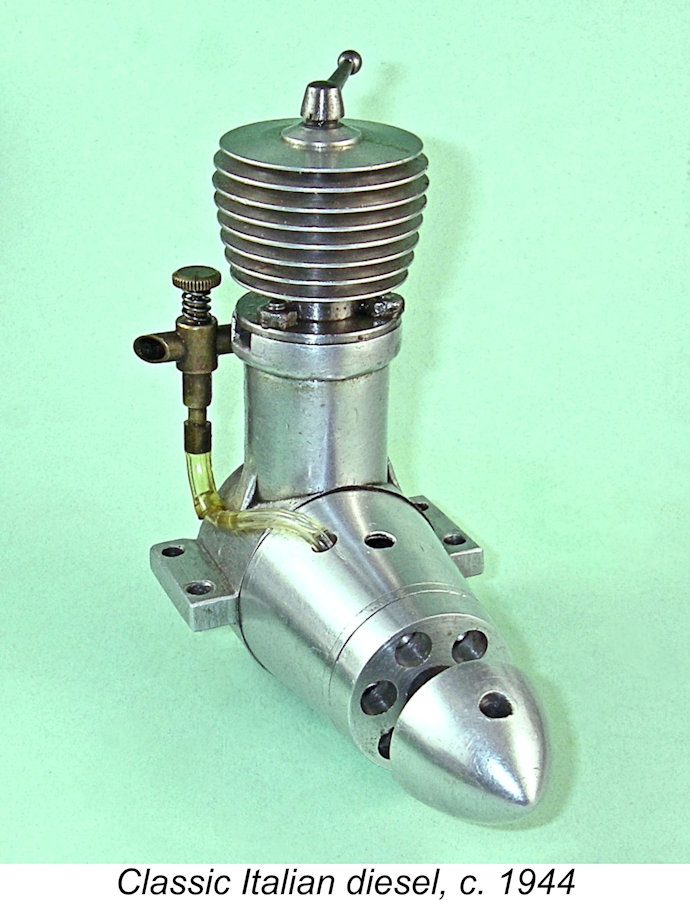 This is one of those remarkable stories which occasionally falls into the lap of a diligent researcher during the course of investigations into a completely different matter. It’s not often that one is lucky enough to uncover the full story of a specific model engine from the pioneering era, but this appears to be one of those rare cases. Moreover, the story is a quite remarkable one!
This is one of those remarkable stories which occasionally falls into the lap of a diligent researcher during the course of investigations into a completely different matter. It’s not often that one is lucky enough to uncover the full story of a specific model engine from the pioneering era, but this appears to be one of those rare cases. Moreover, the story is a quite remarkable one! 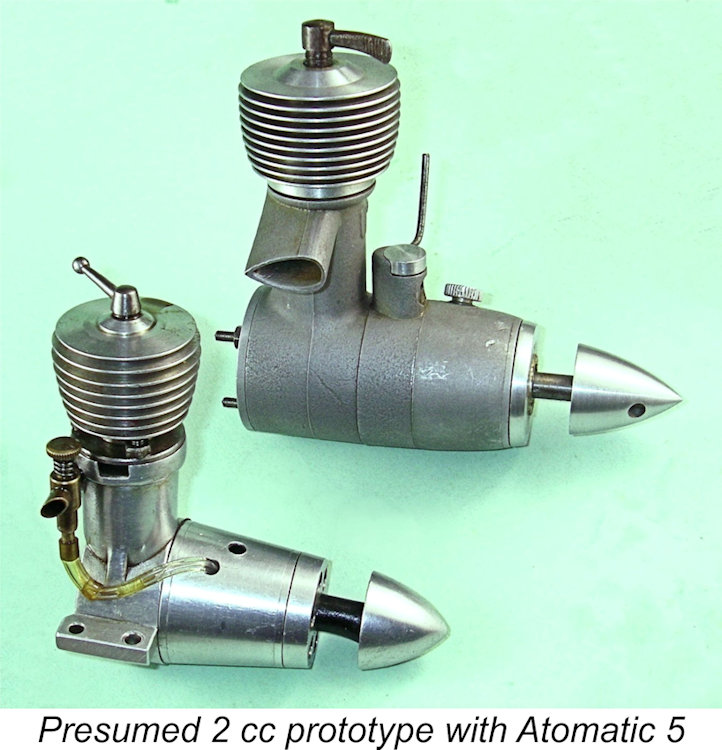
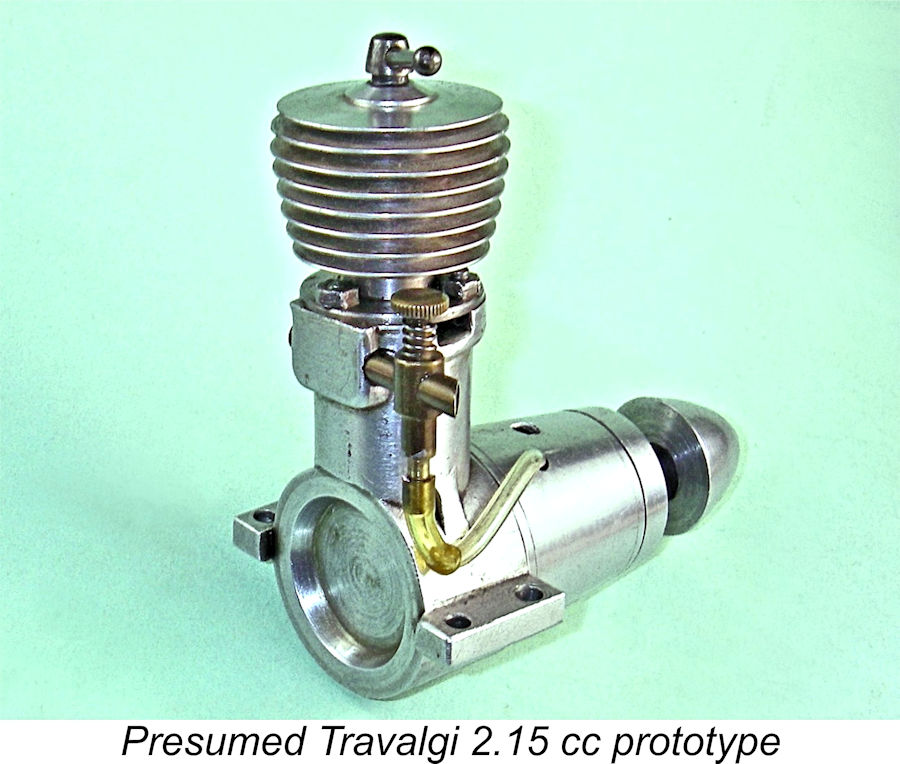 Like all of Travalgi’s work, this 80-year-old engine is beautifully made and still runs well despite a somewhat "soft" piston/cylinder fit. Bore and stroke are 12 mm and 19 mm respectively for an actual displacement of 2.15 cc. The engine weighs a somewhat porky 212 gm (7.48 ounces). It bears no identifying marks whatsoever. See below for some operating impressions.
Like all of Travalgi’s work, this 80-year-old engine is beautifully made and still runs well despite a somewhat "soft" piston/cylinder fit. Bore and stroke are 12 mm and 19 mm respectively for an actual displacement of 2.15 cc. The engine weighs a somewhat porky 212 gm (7.48 ounces). It bears no identifying marks whatsoever. See below for some operating impressions.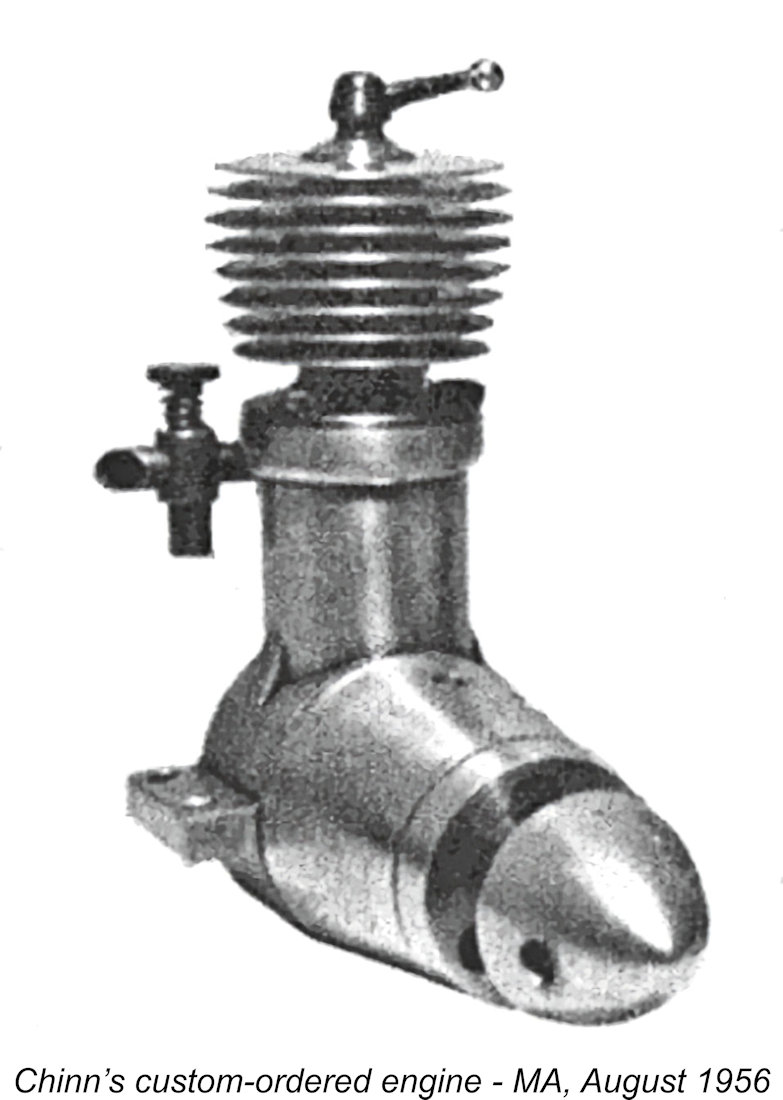 Despite this inconclusive outcome, Peter and I remained convinced that this engine was almost certainly made by Uberto Travalgi while WW2 was still ongoing. There the matter rested until my eagle-eyed mate Gordon Beeby of Australia spotted an article by Peter Chinn entitled "Ten Years of Diesel Progress" which was published in the August 1956 issue of "Model Aircraft". In that article, Chinn included two photographs of an engine which was clearly the very one under discussion!
Despite this inconclusive outcome, Peter and I remained convinced that this engine was almost certainly made by Uberto Travalgi while WW2 was still ongoing. There the matter rested until my eagle-eyed mate Gordon Beeby of Australia spotted an article by Peter Chinn entitled "Ten Years of Diesel Progress" which was published in the August 1956 issue of "Model Aircraft". In that article, Chinn included two photographs of an engine which was clearly the very one under discussion!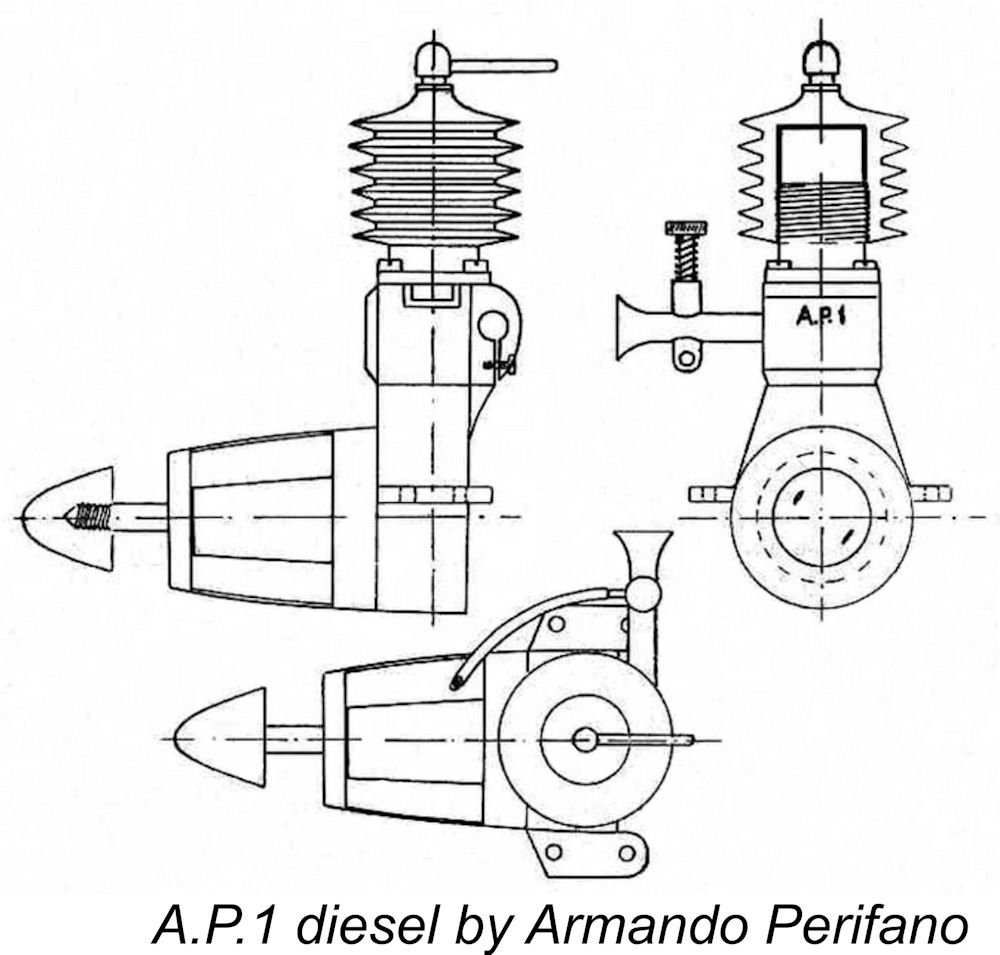 That said, my mate Maris Dislers has pointed out quite rightly that Chinn's custom engine bears some very strong similarities to the A.P. 1 engines produced by Armando Perifano of Naples. According to the invaluable
That said, my mate Maris Dislers has pointed out quite rightly that Chinn's custom engine bears some very strong similarities to the A.P. 1 engines produced by Armando Perifano of Naples. According to the invaluable 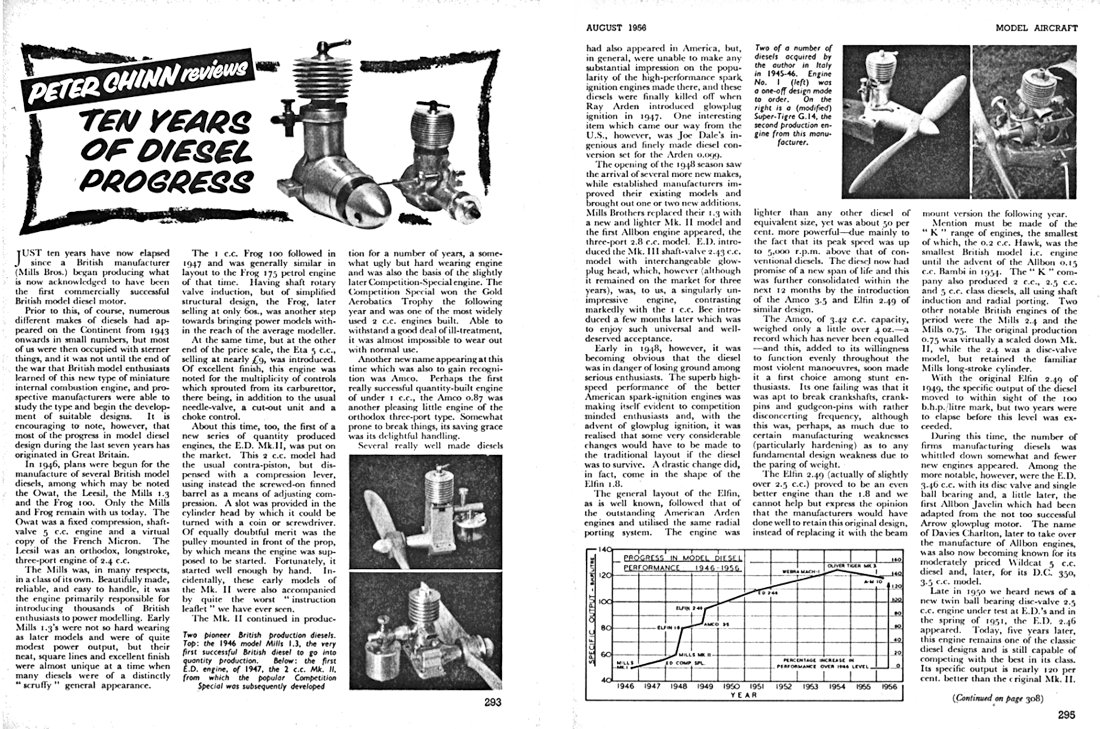 Since he viewed the engine as a one-off custom unit, Chinn understandably never published a test. It evidently remained in his collection as a memento of his early involvement with model diesels, being recalled retrospectively in his 1956 article seen at the right.
Since he viewed the engine as a one-off custom unit, Chinn understandably never published a test. It evidently remained in his collection as a memento of his early involvement with model diesels, being recalled retrospectively in his 1956 article seen at the right.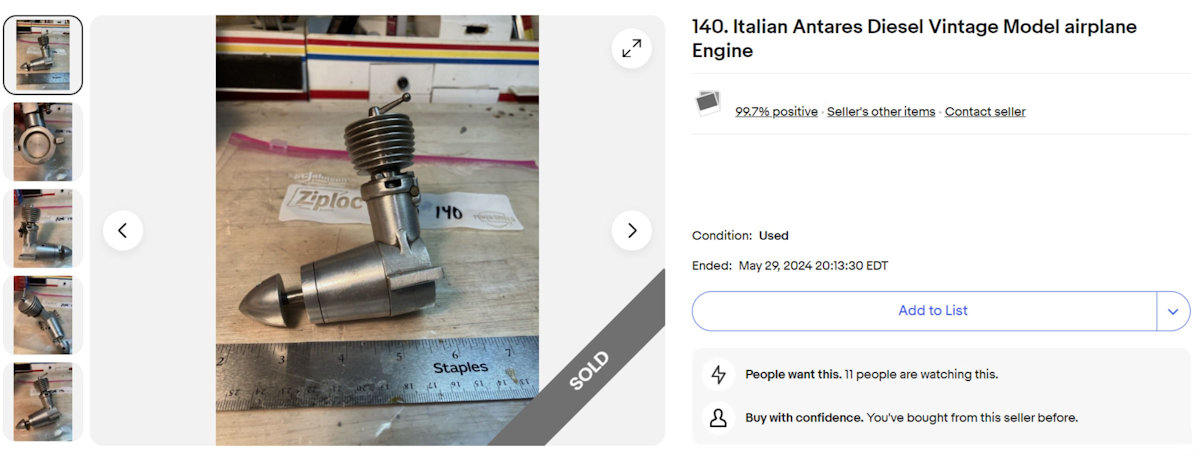
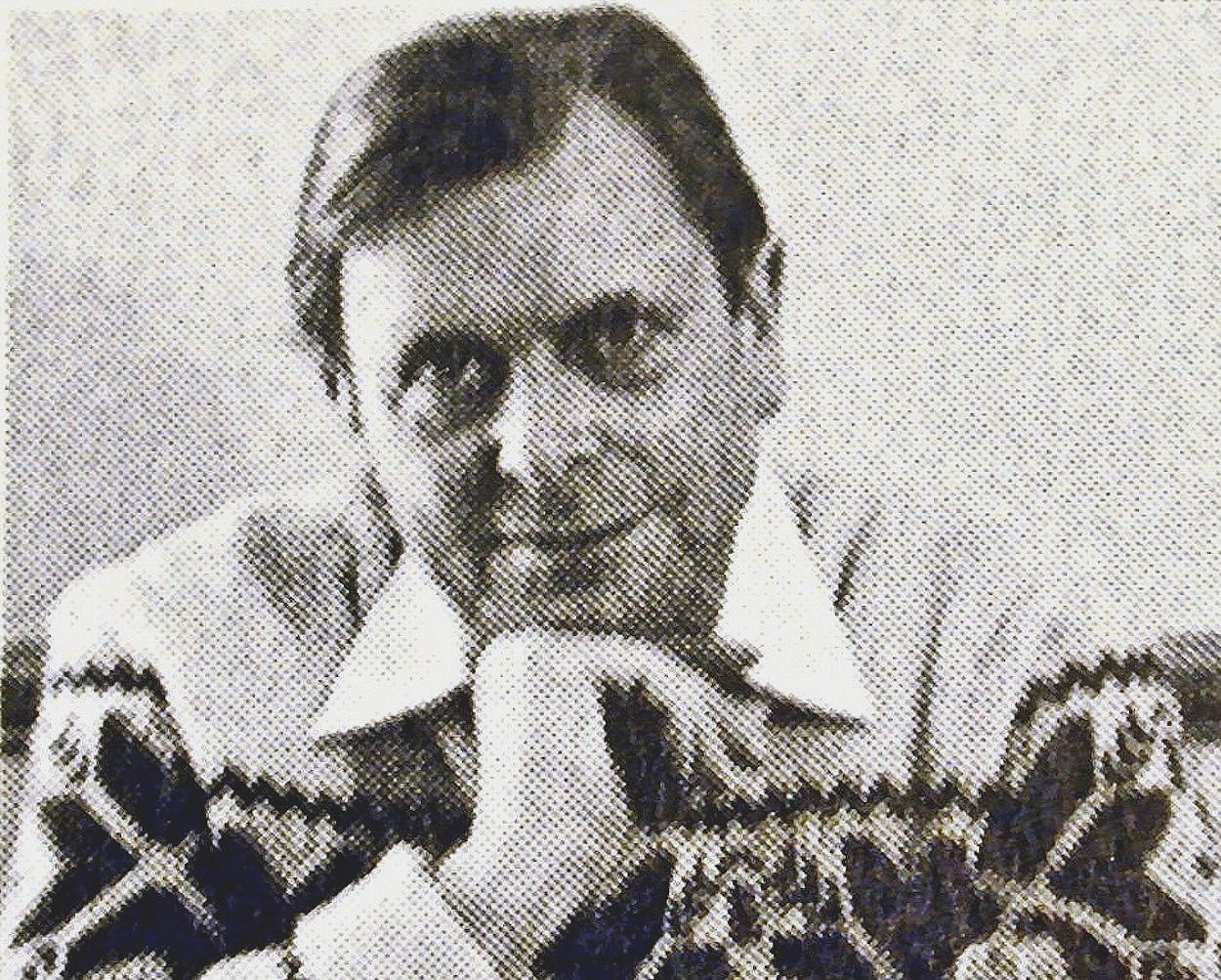
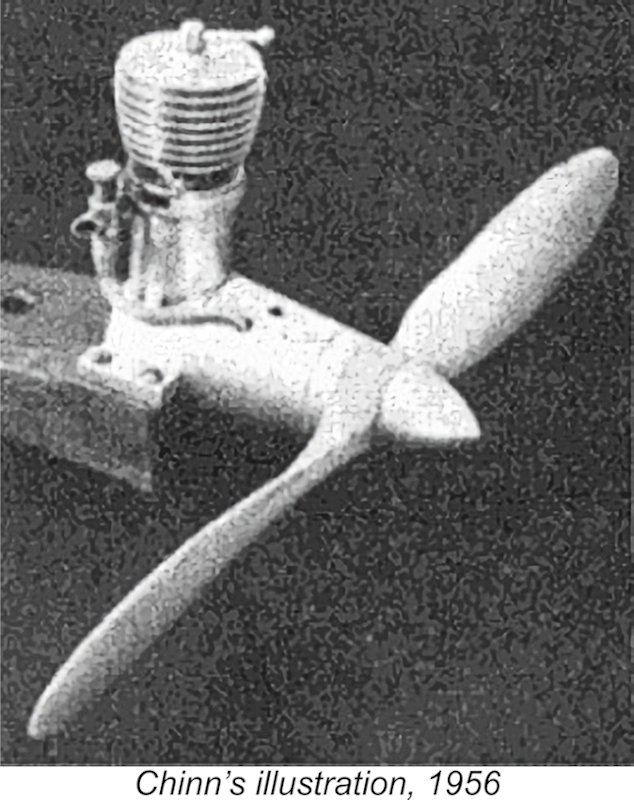 In this instance, the piston was a relatively slack fit when cold. This meant that seizure when hot was extremely unlikely, but the compression seal for cold starting was less firm than ideal. It would most likely be necessary to administer an oil prime to facilitate quick starting.
In this instance, the piston was a relatively slack fit when cold. This meant that seizure when hot was extremely unlikely, but the compression seal for cold starting was less firm than ideal. It would most likely be necessary to administer an oil prime to facilitate quick starting. 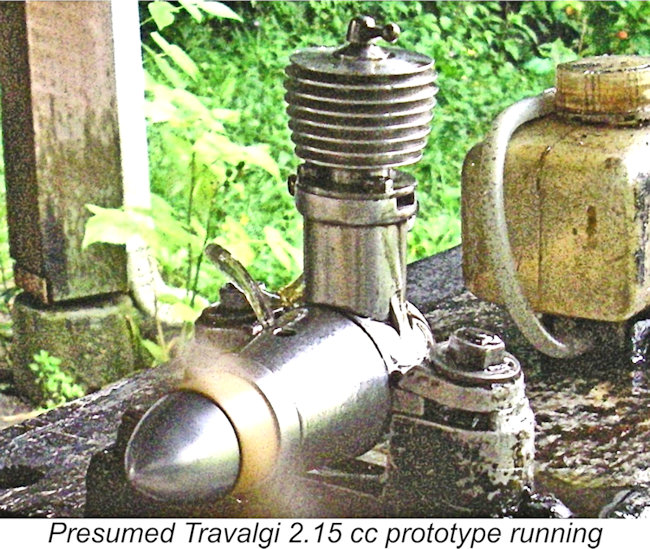
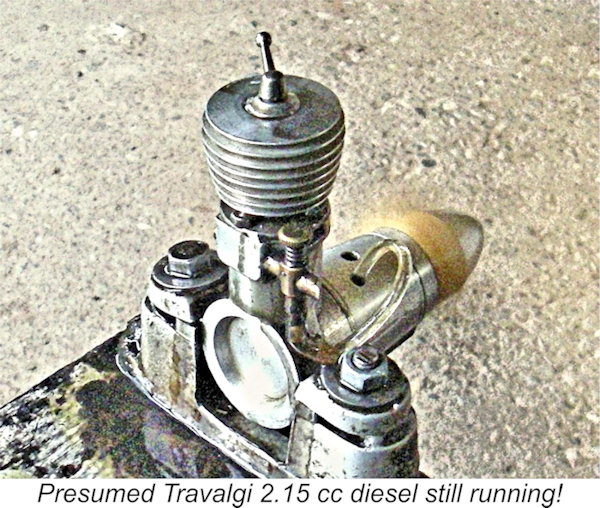 One positive characteristic which became apparent was the fact that the compression seal when hot was significantly better than when cold. I've encountered this before with engines having steel pistons. The piston evidently runs hotter than the cylinder, hence expanding to fit the bore more closely at elevated temperatures - a very positive finding in this instance. Hot restarts were very straightforward using conventional techniques without an oil prime.
One positive characteristic which became apparent was the fact that the compression seal when hot was significantly better than when cold. I've encountered this before with engines having steel pistons. The piston evidently runs hotter than the cylinder, hence expanding to fit the bore more closely at elevated temperatures - a very positive finding in this instance. Hot restarts were very straightforward using conventional techniques without an oil prime.